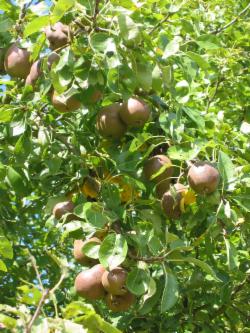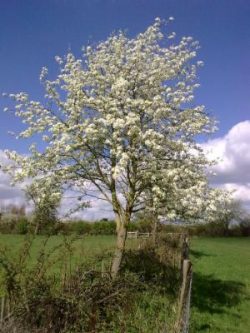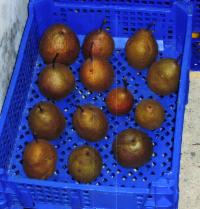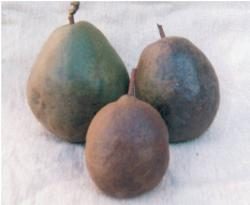 History of the Black Pear
History of the Black PearThe iconic Worcester Black Pear appears today in places such as the city coat of arms, the County Council crest and the cricket and rugby club badges, whilst an image of the pear blossom was borne as a badge by the Worcestershire Yeomanry Cavalry until 1956. The earliest reference to any pear associated with a crest is in relation to the Worcestershire Bowmen, depicting a pear tree laden with fruit on their banners at the battle of Agincourt in 1415. Drayton’s poem of Agincourt mentions the fruit, where it is referred to as the badge of Worcester: “Wor’ster a pear tree laden with its fruit”.
Tradition has it that during the visit of Queen Elizabeth I to Worcester in 1575 she saw a pear tree laden with black pears, which had been moved from the gardens at White Ladies and re-planted in her honour by the gate through which the queen was to enter the city. Noticing the tree Elizabeth is said to have directed the city to add three pears to its coat of arms.
The Worcester Black Pear may originally have been introduced into the country by the Romans and was first recorded from Warden Abbey in Bedfordshire in the 13th Century. It is the oldest surviving cultivar of pears of its type, a group to which the name ‘warden’ or ‘wardon’ pears was given. It is possibly the same cultivar as the French pear ‘de Livre’.
Worcestershire history and place names are littered with references to pears, indicating their past cultural and economic importance to the region. The counties of Worcestershire, Herefordshire and Gloucestershire were the focus of pear introduction to England by the Normans and they have been cultivated ever since. Seedlings from the original trees gave rise to specific varieties for eating, cooking and the production of perry.

Large Worcester Black Pear trees are distinctive within the landscape, growing up to 50ft (15m) tall with a long, relatively narrow crown. The ageing bark has a square checkerboard pattern and in spring the trees are covered with a cascade of white blossom. They are found scattered across the county in old orchards, hedgerows and gardens, often being planted on the windward side of orchards or fields to provide shelter. The trees were commonly grafted onto wild pear rootstock which made them very vigorous, hence the great height they achieved.
Whilst the Black Pear is not now grown commercially it has numerous characteristics to recommend it for this: it is easily cultivated, needs little attention, does well on most soils and has a long life span, good disease resistance and prolific fruit bearing capacity. They also have a pleasing and impressive appearance and their stature makes them suitable for use as a nurse crop or shelter for other orchard trees.
Throughout the 1990s and 2000s Worcestershire County Council made black pears available through its Fruit Trees for Worcestershire scheme and several hundred young trees were planted. Now available from local nurseries on a quince rootstock it can be grown as a smaller tree so making it better suited to gardens and other small sites.
The Black Pear is a cooking or culinary pear which is oval and irregular in shape. Individual fruits can be up to 78mm (3″) wide and 85mm long, weighing as much as 260g. They have a dark mahogany colour (not true black) with russet freckles and small areas of rough skin. The flesh is a pale yellow or cream, tinged green under the skin. A common mistake is to pick the fruit in October or early November and to try to use it immediately, when it is crisp, hard and gritty. They should instead be stored until January and will then keep until April. It was this quality of keeping through the winter without refrigeration that once made them so valuable. Various varieties of Warden pears were supposedly transported with the troops as part of their food provisions because of their long lasting properties.

 How to cook a Black Pear
How to cook a Black PearAs far back as the 13th Century the wardon pear was a baking pear of great repute and was for centuries a favourite for inclusion in pies and pastries, described in every early cookery book. In early literature the warden was considered a distinct type of fruit and lists of fruit varieties included both pears and wardens. Wardon pears in syrup were served in the same course as venison, quail, sturgeon, fieldfare and other high quality dishes. Recipes from a 1450 cookery book include meat and fish cooked with pears, leeks, small onions or garlic sauce.
Hot baked wardens:
6 large firm pears
½ – ¾ pint / 300 – 450ml red wine
1oz / 28g brown sugar
Pinch of ground cinnamon, ginger and saffron
Peel the pears and place in an oven proof dish. Mix the red wine with the brown sugar and spices and pour over the pears. Bake in the oven at 180 C / 350 F / Gas Mark 4 until tender (this can be up to 2 hours in the case of black pears).